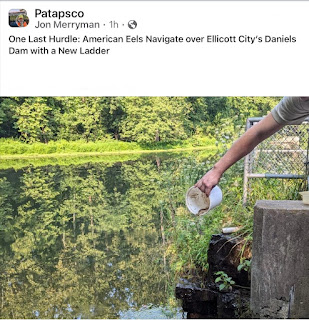What do you know about eels?
You weren’t expecting that, were you?
What I knew: they are slippery and wiggly. They appear a lot in crossword puzzles. And people are forever buying hot eel pies from street vendors in the English historical mysteries I borrow from the library.
What I did not know: eels climb ladders.
Image shared on Patapsco Facebook group
One Last Hurdle: American Eels Navigate over Ellicott City’s Daniels Dam with a New Ladder, Maryland Department of Natural Resources
Umm…a ladder?
First of all, it doesn’t really look like a ladder. You see that white PVC pipe in the far left of this photo? That’s it.
Photo by Joe Zimmermann
Named for its function rather than its form, the eel ladder at Daniels doesn’t resemble a step ladder. It’s more of a simple tube—or a kind of eely waterslide—that stretches from the top of the dam to the water below, where it runs a few feet under the surface and provides an attraction flow that interests eels. The bottom of the pipe is covered with substrate netting that gives the eels enough purchase for their ascent.
But why?
Dams along the Patapsco River interfere with the eels’ natural migration routes. That means less healthy habitat for them, and contributes to a decrease in the eel population. Why should we care?
It seems that these wiggly-looking things play a valuable role in the grand scheme of things, something I would not have known had I not read this article. DNR Biologists Jim Thompson and William Harbold essentially MacGyvered a new eel ladder from easily obtainable materials from the hardware store. It’s a simple design and only cost around six hundred dollars, a good deal less than previously available ones.
If you want to read the article in its entirety, you will learn more about eels than you ever wanted to know. If you are pressed for time, I’ll give you the big news: the ladder is working and the eels are prodigious climbers. Better yet, watch the video:
Back when the dam was built, the power it generated was vital to local industry. That is no longer the case.
Four hundred and fifty feet of stone masonry that cuts straight across the waterway, Daniels Dam has slowed the passage of the Patapsco River a few miles from Ellicott City since the 1830s, when it powered mills for producing canvas and denim. This year, the nonprofit American Rivers began a feasibility study for the possible removal of the dam, which is now long out of use. The Department of Natural Resources, which owns and manages the dam, supported American Rivers’ application to fund the study.
It may be pretty to look at, but dams alter natural habitats and contribute to a significant decrease in freshwater wildlife. In the case of Daniels, which ceased operation long ago, a transition to a dam-less river makes a lot of sense - - especially to the eels. Would you want to climb a forty-three foot ladder if you didn’t have to?
You can follow the Patapsco group on Facebook. Maryland Department of Natural Resources is on Facebook and Instagram.




Comments
Post a Comment